Ever felt a sharp twinge in your knee and wondered if your aching back had anything to do with it? You’re not alone in this thought. It’s not uncommon to feel pain in one area of your body and automatically connect it to discomfort in another. After all, our body works as a synchronized unit, not isolated parts. If your back is giving you grief, it might just be playing a role in that knee pain you can’t seem to shake off. But don’t let this unsettling feeling keep you on the sidelines! Dive in with us as we unravel the intricate connection between back and knee pain, and more importantly, how to address both effectively and reclaim your active life. So, let’s dive in!
Contents
The Anatomy Behind the Connection
 Ever heard of the “kinetic chain”? Picture your body as a series of interconnected links, each one affecting the next. The spine and the knees are pivotal links in this chain. Here’s a breakdown of how they’re functionally intertwined:
Ever heard of the “kinetic chain”? Picture your body as a series of interconnected links, each one affecting the next. The spine and the knees are pivotal links in this chain. Here’s a breakdown of how they’re functionally intertwined:
- Spine’s Role: The spine acts as the main support pillar for our body. When there’s an imbalance or misalignment here, it can create a ripple effect down to the knees. For instance, a lumbar misalignment might cause one hip to drop lower than the other, altering leg length and thus, affecting the knees.
- Knees Feeling the Pressure: The knees are like the shock absorbers of our body. When the spine doesn’t distribute weight evenly, due to issues like herniated discs or muscle imbalances, the knees often bear the extra load, leading to strain or discomfort.
- Biomechanics in Play: Now, let’s talk movement. Every step we take, every jump, every bend involves a synchronized dance between the spine and knees. If the back isn’t moving as it should, the knees might compensate by altering their motion. Over time, this modified movement pattern can lead to wear and tear on the knee joints.
- It Goes Both Ways: It’s a two-way street. Just as back issues can lead to knee problems, chronic knee pain can cause you to adjust your posture or gait. These adjustments might result in additional stress or misalignment in the back.
By understanding the close relationship between our back and knees, it becomes clear that caring for one can directly benefit the other. When addressing pain or discomfort, it’s vital to consider the whole kinetic chain, ensuring both our spine and knees work harmoniously.
Common Causes of Simultaneous Pain

It’s intriguing yet alarming how one body part’s discomfort can set off a chain reaction, affecting other areas. When both your back and knees scream out in pain, it isn’t merely coincidental. Let’s delve into some common culprits behind this dual discomfort:
Postural Imbalances
Our posture, be it while standing, sitting, or moving, can influence the load and stress distribution across our joints. Slouching or uneven weight bearing can put undue pressure on the lower back and, in turn, the knees. Over time, these imbalances can lead to pain in both areas.
Osteoarthritis
This degenerative joint disease often affects weight-bearing joints, with the spine and knees being prime targets. When cartilage wears away, it can lead to pain, swelling, and reduced function in these joints.
Compensatory Walking Patterns
If you’ve ever had a sore foot and limped to avoid the pain, you’ve used a compensatory walking pattern. While these adaptations might seem helpful short-term, they can strain other body parts. A knee injury might cause you to limp, putting more strain on the opposite knee and the lower back, eventually leading to pain in those areas.
Previous Injuries
Past traumas to either the back or knees can make them more susceptible to future issues. For instance, a previously herniated disc can affect your gait, resulting in knee pain.
Muscle Weakness or Imbalance
The muscles in our core, hips, and thighs play a crucial role in supporting our spine and knees. Weakness or imbalance in these muscle groups can pull both the back and knees out of alignment, leading to discomfort.
Understanding these common causes can help pinpoint the root of simultaneous back and knee pain. By addressing the underlying issue, you stand a better chance of breaking the chain reaction and finding relief for both areas.
How Can I Get Relief From Back And Knee Pain?
 When you’re caught in the throes of back and knee pain, finding relief becomes paramount. Thankfully, there are several home remedies and strategies you can employ to ease the discomfort. Let’s walk through some tried-and-true methods:
When you’re caught in the throes of back and knee pain, finding relief becomes paramount. Thankfully, there are several home remedies and strategies you can employ to ease the discomfort. Let’s walk through some tried-and-true methods:
- RICE Technique: Standing for Rest, Ice, Compression, and Elevation, this method is particularly effective for acute injuries. Rest the affected area, apply ice to reduce swelling, use a compression bandage, and elevate to minimize inflammation.
- Warm Baths: Soaking in a warm bath can help relax tense muscles and alleviate pain. For added benefits, toss in some Epsom salts which can reduce muscle soreness and inflammation.
- Over-the-counter Pain Relievers: Non-prescription medications like ibuprofen or acetaminophen can be effective in managing pain and inflammation. Always consult with a healthcare provider and follow the recommended dosage.
- Topical Pain Relievers: Gels, creams, and patches containing ingredients like menthol or capsaicin can provide localized relief for pain.
- Maintain Proper Posture: Whether you’re standing, sitting, or lying down, maintaining a neutral spine can alleviate unnecessary stress on your back and knees.
- Strengthen Core and Leg Muscles: Engaging in regular exercises targeting the core, hips, and thighs can offer support to both the back and knees, potentially reducing pain.
- Gentle Stretching: Incorporate flexibility exercises into your routine. Stretching can release tension, improve blood flow, and enhance overall mobility, mitigating discomfort.
- Anti-Inflammatory Diet: Incorporate foods rich in anti-inflammatory properties like turmeric, ginger, berries, and fatty fish. They can help in reducing inflammation, which often aggravates pain.
- Wear Supportive Footwear: The shoes you wear play a crucial role in aligning your spine and knees. Opt for footwear that offers ample support and cushioning.
- Pillow Support: When sleeping, placing a pillow between your knees (if you sleep on your side) or under your knees (if you lie on your back) can alleviate strain on both the back and knees.
Remember, while these remedies can offer relief, they are not a substitute for professional medical advice. If your pain persists or intensifies, it’s essential to consult with a healthcare provider to address any underlying conditions.
Exercises to Strengthen Both Areas
When you’re experiencing both back and knee pain, it’s crucial to target exercises that can strengthen and stretch these areas simultaneously. By honing in on exercises that benefit both parts of your body, you can enhance the functional relationship between the two and potentially alleviate pain. Here are some exercises to incorporate into your routine:
Bridges
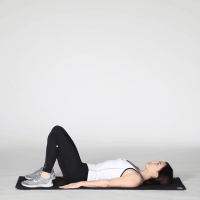
- How: Lie on your back with knees bent and feet flat on the floor, hip-width apart. Press your feet into the ground and lift your hips towards the ceiling. Hold for a count of two, then lower back down.
- Benefits: Strengthens the lower back, glutes, and hamstrings, providing support to the knees.
Quadruped Leg Lifts

- How: Start on all fours. Keeping the knee bent, lift one leg up towards the ceiling, then lower it down. Repeat on the other side.
- Benefits: Enhances core and lower back strength while engaging the glutes, supporting the knees.
Knee-to-Chest Stretch
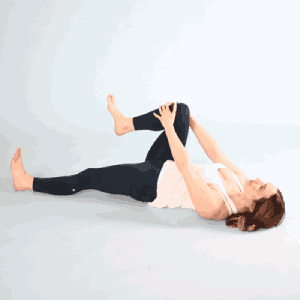
- How: Lie on your back and pull one knee towards your chest, holding it with both hands. Hold for 20-30 seconds, then switch legs.
- Benefits: Stretches the lower back and relieves tension.
Wall Sits
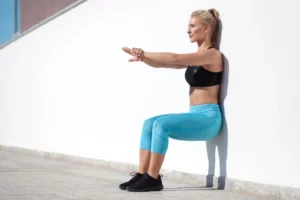
- How: Lean against a wall with feet shoulder-width apart. Slide down until your knees are at a 90-degree angle. Hold for 20-30 seconds.
- Benefits: Strengthens the quadriceps, providing better support for the knees and reducing strain on the back.
Cat-Cow Stretch
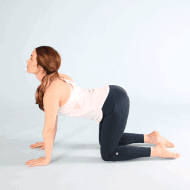
- How: Begin on all fours. Arch your back, lifting your head and tailbone towards the ceiling (Cow). Then, round your spine, tucking your chin and tailbone (Cat).
- Benefits: Enhances flexibility and strength in the spine, relieving back pain.
Hamstring Stretch
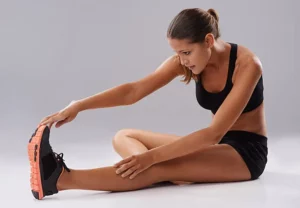
- How: Sit on the floor with one leg extended and the other bent inward. Lean forward gently towards the extended leg, keeping your back straight. Hold for 20-30 seconds, then switch legs.
- Benefits: Stretches hamstrings, reducing tension on the back of the knee and lower back.
Planks

- How: Begin in a push-up position but keep your weight on your forearms instead of your hands. Keep your body in a straight line from head to heels. Hold for as long as comfortable.
- Benefits: Strengthens the core, which in turn offers better support to the back and knees.
Step-Ups
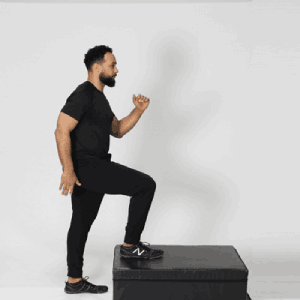
- How: Using a sturdy platform or step, step up with one foot, followed by the other, then step back down.
- Benefits: Strengthens quads, hamstrings, and glutes, offering dual support to both the knees and back.
Incorporating these exercises into your routine can enhance the strength and flexibility of both your back and knees. However, always remember to consult with a physical therapist or healthcare provider before starting any new exercise regimen, especially if you have pre-existing conditions.
Effective Therapies for Dual Relief
When battling both back and knee pain, there are therapeutic interventions tailored to treat both simultaneously, optimizing your road to recovery.
- Physical therapy offers targeted exercises and techniques that strengthen and rehabilitate affected areas, promoting better movement patterns.
- Acupuncture taps into the body’s energy meridians, potentially alleviating pain and inflammation in both regions.
- A therapeutic massage can release muscle tension and improve circulation, easing discomfort in the back and knees alike.
- Lastly, chiropractic care focuses on spinal adjustments, which can positively influence knee function due to the interconnected nature of our biomechanics.
Leveraging one or a combination of these therapies can pave the way for holistic healing and relief.
Avoiding Common Mistakes For Long Term Relief
While striving for pain relief, many inadvertently worsen their situation through common mistakes. Let’s highlight these pitfalls and how to sidestep them, ensuring a path toward lasting relief:
- Improper Lifting Technique: Lifting heavy objects without using the legs is a fast track to back strain. Always bend at the knees, not the waist, and use your legs’ power to lift, keeping the object close to your body.
- Over-exercising Without Recovery: Intense workouts without allowing adequate recovery time can stress both your back and knees. It’s essential to listen to your body and incorporate rest days.
- Neglecting Posture: Slouching or standing improperly can cause an undue load on both your spine and knees. Regularly check your posture, and if needed, seek ergonomic solutions for your workspace.
- Wearing Inappropriate Footwear: High heels or unsupportive shoes can alter your body’s alignment, leading to back and knee pain. Opt for footwear that provides adequate support and cushioning.
- Skipping Warm-ups: Jumping into exercises without warming up can jolt your back and knees. Engage in dynamic stretches and gradual warm-ups to prepare your body for activity.
- Ignoring Persistent Pain: Pushing through the pain, thinking it will just “go away,” can lead to chronic issues. If you experience consistent discomfort, it’s wise to consult a healthcare professional.
By sidestepping these frequent missteps and incorporating preventive habits, you’ll be better positioned to protect both your back and knees from prolonged discomfort.
Conclusion
Your back and knees are intricately linked, and understanding this connection is pivotal to maintaining their health. As we’ve explored, there are several mutual influencers that can be both a bane and a boon. It’s not just about reacting to pain; it’s about proactive care, understanding the dos and don’ts, and making informed decisions. By staying aware and avoiding those common pitfalls, you’re already on a path to a more pain-free life. If you’re experiencing Knee pain, physical therapy for knee pain at PhysioMantra can help: Book an online physical therapy session.



